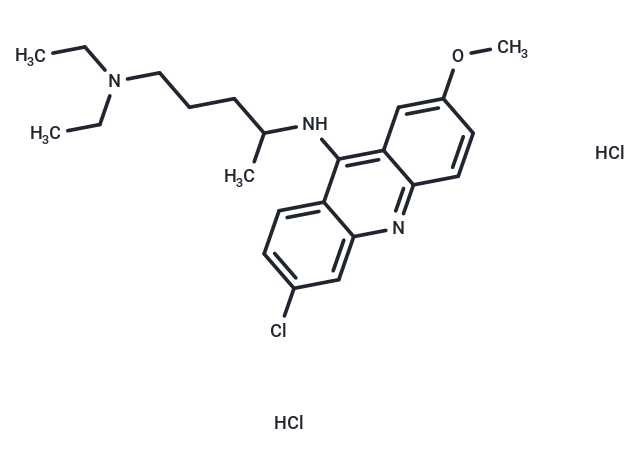Shopping Cart
Remove All Your shopping cart is currently empty
Your shopping cart is currently empty
Quinacrine dihydrochloride (Mepacrine dihydrochloride) is the dihydrochloride salt of the 9-aminoacridine derivative quinacrine with potential antineoplastic and antiparasitic activities.

| Pack Size | Price | USA Warehouse | Global Warehouse | Quantity |
|---|---|---|---|---|
| 100 mg | $41 | In Stock | In Stock | |
| 500 mg | $81 | In Stock | In Stock |
| Description | Quinacrine dihydrochloride (Mepacrine dihydrochloride) is the dihydrochloride salt of the 9-aminoacridine derivative quinacrine with potential antineoplastic and antiparasitic activities. |
| Synonyms | SN-390, Quinacrine 2HCl, Mepacrine dihydrochloride |
| Molecular Weight | 472.88 |
| Formula | C23H30CLN3O·2HCl |
| Cas No. | 69-05-6 |
| Smiles | CCN(CC)CCCC(C)Nc1c2ccc(cc2nc2c1cc(cc2)OC)Cl.Cl.Cl |
| Relative Density. | 1.2962 g/cm3 (Estimated) |
| Color | Yellow |
| Appearance | Solid |
| Storage | keep away from direct sunlight | Powder: -20°C for 3 years | In solvent: -80°C for 1 year | Shipping with blue ice/Shipping at ambient temperature. | |||||||||||||||||||||||||||||||||||||||||||||
| Solubility Information | H2O: 49 mg/mL (103.62 mM), Sonication is recommended. DMSO: 4.73 mg/mL (10 mM), Sonication is recommended. Ethanol: 27 mg/mL (57.1 mM), Sonication is recommended. | |||||||||||||||||||||||||||||||||||||||||||||
Solution Preparation Table | ||||||||||||||||||||||||||||||||||||||||||||||
DMSO/Ethanol/H2O
Ethanol/H2O
H2O
| ||||||||||||||||||||||||||||||||||||||||||||||
| Size | Quantity | Unit Price | Amount | Operation |
|---|

Copyright © 2015-2025 TargetMol Chemicals Inc. All Rights Reserved.